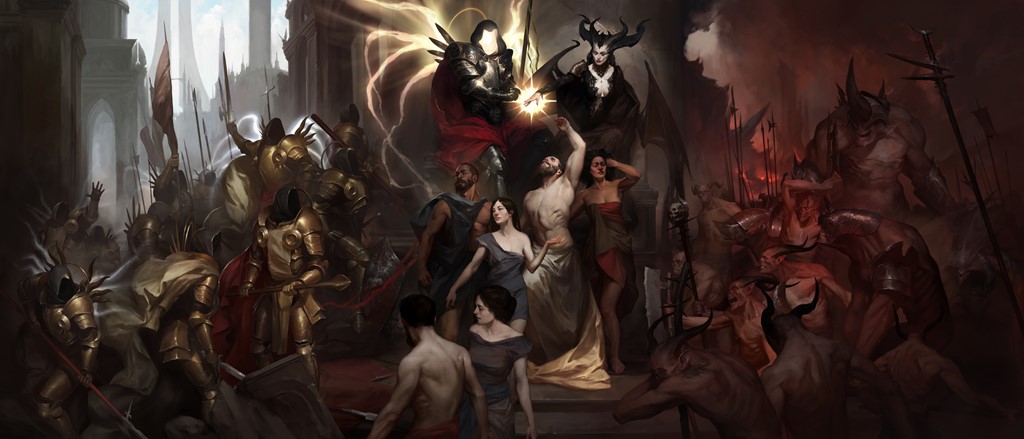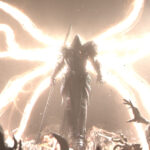Players can be quite confused at who Inarius and Lilith when they have almost no exposure to either of them before Diablo IV’s launch. Inarius is a rogue angel and Lilith is a rogue demon who created Sanctuary as a means to escape the Eternal Conflict between angels and demons over the Worldstone (the focus of Diablo II). They birthed the nephalem which eventually over time became humanity.
That’s everything. We have a ton of technical lore history below, but if you’re just curious who they are that’s about the best summary I think you can have. When they introduce themselves in the game as the mother and father of Sanctuary, they’re not lying.
There’s a lot more technical info on the situation than that, but we first need to talk about what came about to cause them to create Sanctuary. We’ll then go into a mixed bag of topics about Inarius, Lilith and Sacntuary to help catch you up.
I, the writer, have finished Diablo IV’s campaign and feel that a lot of the extra details from the campaign aren’t necessary to answer the question. To help answer the questions without spoiling the fun of the game, this guide will avoid any spoilers from the video games and instead focus on overviews of events that occurred before Diablo IV starts.
The Start of Creation
It feels as if Sanctuary is just a battleground between the player and Diablo in the few instances we’ve been exposed to it in the video games. It’s a large vast and well inhabited world that’s brutal, harsh and unforgiving. It has had countries and cultures rise and fall and several ages come and go. While it may feel as if the eternal conflict is between the player character and Diablo, it’s actually between the emotions of Anu.
At the start, there was only Anu. Anu cast evil away from themselves and created Tathamet. The two fought until they bested each other, creating the High Heavens from Anu and the Burning Hells from Tathamet. The Eye of Anu became the Worldstone and was stored in Pandemonium Fortress. A location during this early ear that swapped hands frequently between angels and demons, causing it to warp between the drastically opposing sides.
For the demons, Tathamet had seven heads and those heads became the seven Great Evils. Mephisto (Hatred), Diablo (Terror) and Baal (Destruction) are the Prime Evils and Andariel (Anguish), Duriel (Pain), Belial (Lies) and Azmodan (Sin) as the lesser evils.
In the High Heavens, the Crystal Arch, made of Anu’s spine, vibrates in perfect harmony from time to time creating an angel embodying an aspect of what Anu had been at one time. The purest become archangels, which currently there are five major ones and a rebel: Imperius (Valor), Itherael (Fate), Malthael (Wisdom), Auriel (Hope), Inarius (Rebel) and Tyreal (Justice / Wisdom).
In Pandemonium is the Worldstone, or Eye of Anu, which has the power of Anu within it. The Eternal Conflict was a war between the High Heavens and Hell over control of the Worldstone.
The Creation of Sanctuary
Pandemonium Fortress was an endless battlefield with the demons and angels taking control back and forth endlessly. Neither side made any advances and were actually quite content with this. Inarius went through a few situations where he eventually met Lilith, a demon, and they both shared a similar goal: to end the eternal conflict between the two realms.

They went to the Worldstone and moved Pandemonium Fortress to a pocket dimension, creating a sanctuary that they dubbed Sanctuary. The demons and angels who no longer wanted to fight in the war joined them and created the nephalem. This scared many because their potential was greater than any single angel or demon. Lilith, deciding the best way to save her creation, was to murder all the angels and demons who had joined them in rebellion. Inarius didn’t quite enjoy that, so he banished Lilith from sanctuary and used the Worldstone to tune down the powers of the nephalem and disappeared for a bit.
Over time the nephalem’s power faded and they became mortals, known as humankind. Lilith was banished and Inarius goes on to be involved a few other adventures such as:
- The Sin War (Book Series): Stalemate where Sanctuary becomes its own realm owned by humanity, who get to pick who they want to side with in the eternal war.
- Mephisto Rips Inarius’s Wings Off: Inarius, who was given to the demons, has his wings ripped off by Mephisto over a period of unknown time.
Cathedral of Light
This isn’t mentioned much previously in the games, but this is explained outside of Diablo IV during the events between Diablo III and Diablo IV which is roughly 50 years. Inarius returns after escaping his confinement and reforms the Cathedral of Light, a religion that was based around him long ago, for his own selfish reasons. So if you go into Diablo IV and you’re like what’s this thing, do know that it’s a recent event. After Diablo III the world of Sanctuary goes into an even more miserable state of affairs.
Which, it’s hard to see that but it’s actually a bit easier to put it this way. In Diablo II all the cities you visit are actually doing rather okay. In Diablo III, they were all doing alright until Diablo III. In Diablo IV, the world is vibrantly lived in, but everything is a literal war encampment and the heroes have almost all but given up.
Who is Inarius Exactly?
He’s a rogue angel who conspired with Lilith to create Sanctuary. He was originally a much more relevant player on Sanctuary but disappeared for a while, was captured and imprisoned and then recently in the last 50 years broke free.
Who is Lilith Exactly?
She’s a rogue demon, daughter of Mephisto, who conspired with Inarius to create Sanctuary. She was banished from Sanctuary by Inarius for killing all of the rebel angels and demons who had joined them.
Did Inarius and Lilith Exist Before Diablo IV?
No, this was in several books from ~2007. It was roughly new then though! In Diablo and Diablo II there weren’t any specifics to the lore until the Sin War books came out. Then Sanctuary was more well defined, including its creation. The Sin War was referred to in the books that came out in the early 2000s, but the actual description of Inarius and Lilth was more towards the 2007 Sin War books.
This isn’t technically new, but you can be forgiven for feeling it was a bit not ever mentioned in Diablo II proper. There’s some debate in the community about defining what Sanctuary was gave the world less “atmosphere” since it’s less of a mystery, but to be fair this information at the time required reading books which isn’t the same as being told in the game.
Who is Rathma?
The first human, known as Linarian, the first Nephalem and the most powerful of them all. Diablo IV does Rathma really weird. He’s not given any really good exposition. He chills out with a mystical being known as Trag’Oul to sabotage his parents’ plans and keep humanity neutral. Out of everyone, going into Diablo IV you’d think Rathma would be the most central of the save humanity, but that’s not how Diablo IV goes.
You will at least hear of Rathma a lot in Diablo IV. Rathma IS NOT ELIAS. Elias is a mage. Rathma IS NOT THE PERSON IN THE INTRODUCTION CUTSCENE TO DIABLO IV. Rathma has long black hair and wears a necromancer garb. The person in the introduction cutscene is Elias, an entirely new person introduced in Diablo IV. The opening cutscene has Elias bringing Lilith to Sanctuary in a Triune temple, something that Rathma wouldn’t do. The Triune were the demon’s attempt to lure humanity to their side and Rathma wasn’t into that.
Who is Elias?
Elias is exclusive to Diablo IV. Don’t feel odd if you don’t know who he is. The only thing about Elias before Diablo IV was in 2022 with the Diablo Sanctuary Tarot Deck where he was the Hierophant. You find out more about him throughout Diablo IV, so it’s tough to give any kind of strong background without spoilers but a quick summary would be he’s an ex-Horadrim (hence a mage or wizard) who led a monk and two other adventurers into a Triune temple. There he’s dressed as bandit hunting gold and is seemingly killed. He then reveals himself in the next part afterwards where he summons Lilith into Sanctuary.
Elias is gifted immortality through a secret that you must uncover in the game, which allowed him to survive the opening cutscene, withstand summoning a lesser evil such as Lilith and survive a cutscene that will confuse you as to how he could escape from that.
Diablo IV’s Place in the Multiverse
To answer this question, without any spoilers, Sanctuary exists in a pocket dimension. A creature who split itself into good and evil, then died, spilled out angels and demons who, when some rebeled, created hybrids known as nephalem. These nephalem were stronger than the demons and angels, having all of Anu (the original creature’s power). Inarius uses the Worldstone to gradually remove the power from them, creating humans while Lilith gets banished. Sanctuary remains in the pocket dimension.
Nothing so far has indicated that Sanctuary has left that pocket dimension, so that means Sanctuary remains completely isolated from the Warcraft and Diablo franchises. Sanctuary is a creation of Lilith and Inarius and as such, doesn’t exist in the Twisting Nether or traditional space, which would be required for any potential crossover.
Nephalem Power Creep
The Nephalem are not addressed in Diablo IV, at least yet. They are mentioned, they’re spoken of, but it’s not brought up. The long story short is that the Worldstone, no longer existing, no longer caps the power of the Nephalem. When they emerge in the world of Diablo, like in Diablo III, their power is greater than both Demon and Angel. This is amazing when it’s on the side of humanity. This isn’t if they were to choose a different side.
This isn’t addressed and it’s assumed that such a thing to worry about will be addressed either in the live service section of Diablo IV or in another game.
Diablo IV’s Love Letter to the Early Lore
Diablo IV is a literal love letter to the early lore of Diablo, including the Sin War books and pretty much every man canonical book that hasn’t been previously retconned. It tastefully ignores Diablo III, while still acknowledging the state of the world post the events of that game. It returns to a lot of what made Diablo II delightful and that’s kind of neat.
The only issue is that it never really explicitly says who Inarius and Lilith are. Giving players who never explored the lore or looked it up an idea of if they’re telling the truth or not. Going into Diablo IV knowing Lilith is the actual mother of the world and that’s not just some made up title is a lot different than seeing Lilith and going oh, that’s a demon and they’re absolutely evil and nothing they say is true.
I hope this trip through Diablo’s backstory has helped flesh the world out. If you’re curious to keep reading, I suggest checking out Lorath’s narration of events over on YouTube. It gives you the full walkthrough of the past and the previous games if you’re interested.





